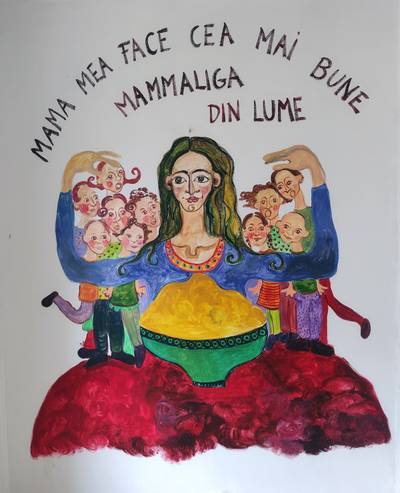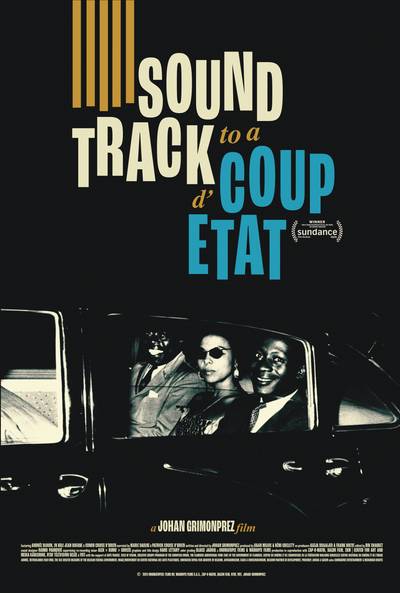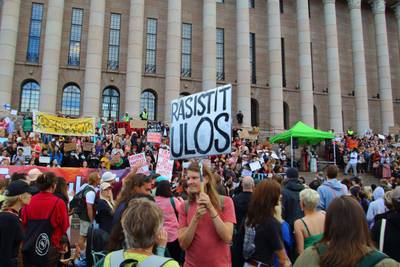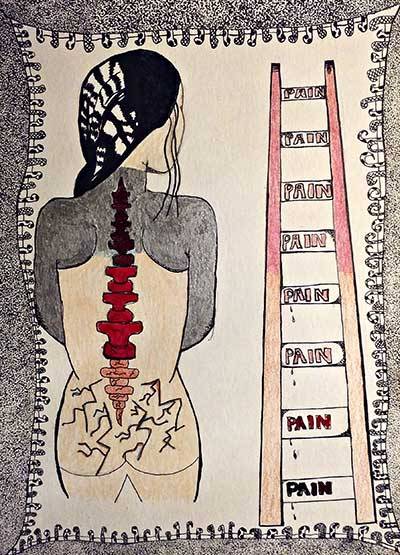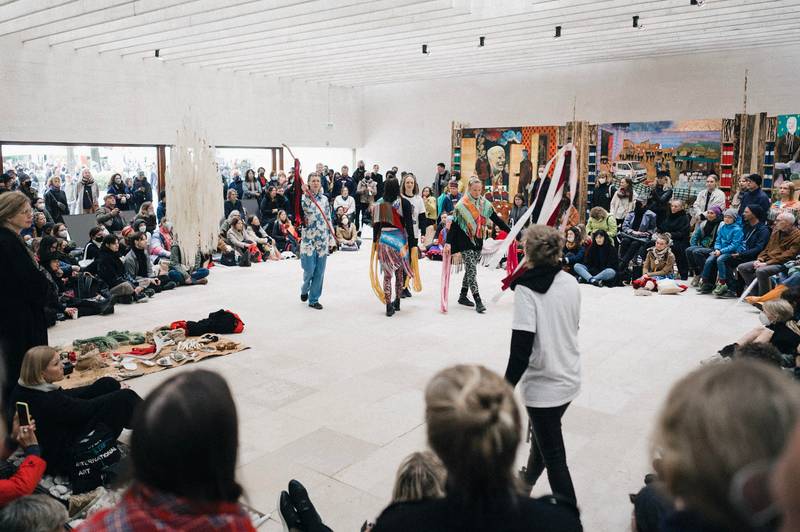

Pauliina Feodoroff, ‘Matriarchy’ at ‘The Sámi Pavilion’, 59th International Art Exhibition – La Biennale di Venezia | Photo: Michael Miller / Office for Contemporary Art Norway (2022)
Satu Herrala is a curator and researcher with a background in dance and choreography. She is interested in how attuning to bodily coexistence informs ways of being, knowing and acting and how collective action emerges from embodiment.
I understand curatorial work as a field of operations, which entails organizing particular conditions for art to emerge and negotiating relations between art’s creation, production, participation, communication, and reception. Since 2016, I have carried out my doctoral studies at Aalto University School of Arts, Design and Architecture (FI) alongside my curatorial practice. My desire to do doctoral research on curating arose from a need to give myself time to reflect on curatorial processes and share my learnings and unlearnings with others. The research scope and focus gradually and significantly changed through the years. I started with inquiring into conditions that turn artistic events into political events and slowly arrived at ‘embodiment’ as I realized that I curate from, with and for the body. This text is based on my ongoing research, ‘Embodied Curating as a Methodology for Ethical Intra-Action – Assembling conditions for art to summon collective and transformative agencies.’ It aims to open up the questions, insights, and complexities I am engaged with and remain curious about in my work.
Bodies that create, produce, contribute, supply, sustain, and engage with art are frequently taken for granted and burdened with assumptions. What would happen when we acknowledge that we are not only social, cultural and rational beings but we exist in bodiliness? Could directing attention to embodiment as well as to the knowledges and agencies that emerge from gatherings of embodied beings foster the social impact of art and artists?
The context of my research is situated mainly in contemporary performance and live arts. Live art is based on, but not limited to, bodily coexistence: a temporary community sharing time and space. Bodily coexistence often creates profound experiences of connection between those who are present. I am interested in the potential that emerges from these connections.
My experience tells me that a lack of consideration for bodies withers the potential of art and a sense of agency for artists and audiences. Bodies that create, produce, contribute, supply, sustain, and engage with art are frequently taken for granted and burdened with assumptions. What would happen when we acknowledge that we are not only social, cultural and rational beings but we exist in bodiliness? Could directing attention to embodiment as well as to the knowledges and agencies that emerge from gatherings of embodied beings foster the social impact of art and artists? Acknowledging our existence as bodies among myriad bodies can strengthen the potential of art to be a transformative collective force in society. According to feminist theorist Karen Barad, knowing cannot be separated from being: “We don’t obtain knowledge by standing outside the world; we know because we are of the world.” (Barad 2007, p. 185). What happens when we consciously attune to our being in the world as a material-discursive phenomenon, and how do we do that?
Karen Barad’s agential realism and the concept of intra-action offer a fruitful frame for examining curatorial work, especially from the point of view of embodiment. Agential realism is a theory developed by Barad based on the thinking of the physicist Niels Bohr, combining the natural sciences and social sciences, where reality is formed in the continuous interweaving of material and discursive factors. It requires the rejection of the subject-object dichotomy, cause-and-effect causality, human-non-human binary, linear time, and individual agency (Barad, 2007). Intra-action is a Baradian term to replace interaction, which assumes that pre-established bodies interact with each other. Intra-action acknowledges that matter is not predetermined. Agencies do not precede but emerge from their intra-action. Our being and agency are entangled with other agencies, without a self-contained, independent existence, and constantly becoming with everything and everyone we encounter. Therefore, we must pay attention to how we intra-act.
Another prolific theoretical [and practical] framework to orientate my research practice is Bodies of Water / Hydrofeminism, articulated by cultural theorist, writer, and teacher Astrida Neimanis. Hydrofeminism invites us to think of embodiment as watery, considering how all living beings are made of water and participate in the same cycles of intake, transformation, and exchange of water, or hydrocommons. It also invites us to acknowledge that we humans do not have exclusive rights to embodiment and that the soft, leaky containers that hold our waters have never been only human. Through watery embodiment, we enter relationships of gift, theft, and debt with other bodies of water. What is our responsibility to all other watery life on this wet, blue planet? How does that come to matter in our meaning-making and mattering? Hydrofeminism is a framework of reciprocity, care, accountability, responsibility, and ethics that incorporates all life and activity. Its scope is enormous, even unthinkable; therefore, I can only approach it as something practical in daily life by slowing down my automatic, habitual functioning to pay attention to how I participate in hydrocommons and what kind of choices I can make to care not only for my own body of water but for the local and always also planetary flows of water and (therefore) life. (Neimanis, 2017).
Ongoing Learnings and Research on Embodied Curating
My research aims to create proposals, tools, and methods that could be of practical use in artistic and curatorial work and in practices that combine art and activism or art and political work. I also learn from activist strategies and how they can be applied to artistic and curatorial processes.
Next I will introduce three artistic, curatorial and discursive projects – Make Arts Policy Summit (2014), Vuosttaš álbmogat / First Nations programme (2017), and the ongoing project Forest as a Geopolitical Stage (2020-2024) – that form a basis for my research work. The research material consists of documentation of past processes and events, journalistic traces, interviews, reflections, planning, implementation, documentation, and critical examination of the ongoing project. The three projects are very different; they required me to move between different positions and research methods. They also allowed me to examine specific processes and events from the perspective of curatorial research, especially from the point of view of embodiment. I participated in these examples mainly as a curator and researcher who organizes conditions, facilitates and mediates situations, collects material, reflects, analyzes, communicates, and shapes forms and formats with various collaborators. Sometimes I position myself as an artist or a pedagogue, for example, when I direct movement workshops for curators, artists, or incarcerated people. The materials move from the micro level to the macro level, from listening to the rhythm of the breath to an activist kind of mobilizing.
A simple gesture of raising a card created a collective agency in the crowd. When lifting a card among hundreds of people performing the same action, I remember feeling the capacities of my body grow in a large collective body, interrupting a flow of speech and demanding a member of the parliament to “Be concrete!”. It felt like riding a big wave together.
Make Arts Policy Summit was a gathering of art workers, civil servants, policymakers, cultural journalists and politicians from 10 Finnish political parties to discuss the future of arts and cultural policy before the parliamentary elections of 2015. The summit was organized in November 2014 at Helsinki City Hall by the Baltic Circle International Theatre Festival, Checkpoint Helsinki (transformed into the curatorial agency PUBLICS in 2017), and the Public Movement research body, and curated by Terike Haapoja, Eva Neklyaeva, Dana Yahaolmi, and myself. During the previous parliamentary elections in 2011, the far-right populist political party “Finns Party” made provocations about art and culture in their political programme, such as that state funding should not include “experiments of postmodern fake art” (PS 2011). It was unclear what views and intentions the other parties had regarding arts and culture, as they were not given much space in the election debates. We felt it was time to discuss this publicly and raise art and culture on the party agendas so that the constituents could know what their representatives would push for in Parliament.
Yahalomi designed a system of cards that allowed the public to interrupt the politicians’ speeches with a demand and a question: “Be Concrete!” and “Why?” When enough cards were up in the air, a band on the stage next to the politician started to play and interrupted their speech. A simple gesture of raising a card created a collective agency in the crowd. When lifting a card among hundreds of people performing the same action, I remember feeling the capacities of my body grow in a large collective body, interrupting a flow of speech and demanding a member of the parliament to “Be concrete!”. It felt like riding a big wave together.
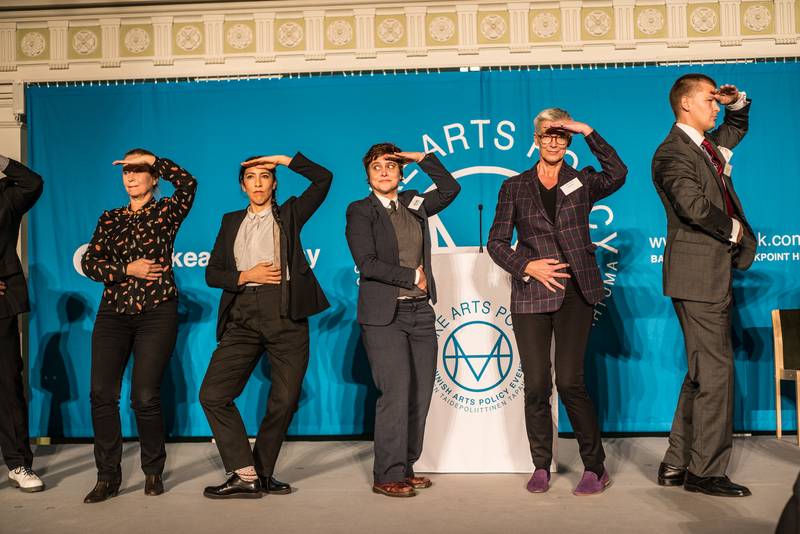

Make Arts Policy Summit, politicians and leaders from the Finnish art scene dancing the ‘Hymn of The Austrian Federal Ministry for Movement Affairs (BMfB.at)’ as a symbolic gesture for the future of Finnish arts policy, 2014 | Photo: Noora Geagea / Baltic Circle & Checkpoint Helsinki
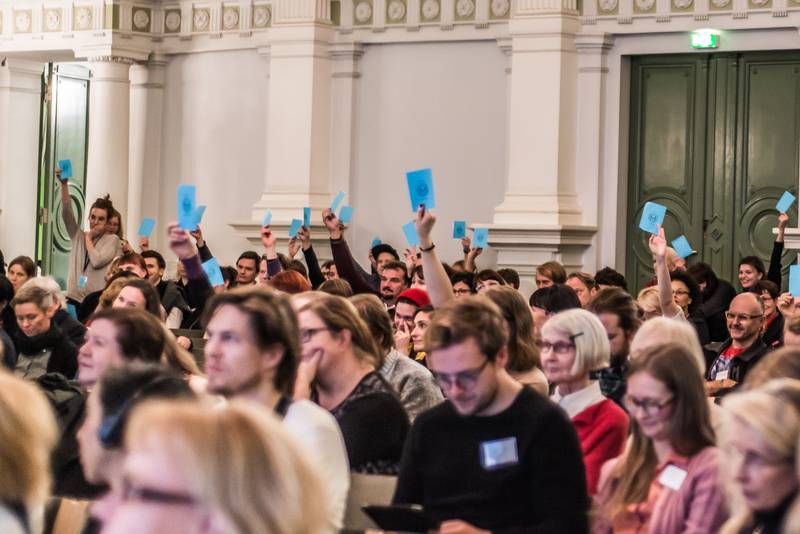

Make Arts Policy Summit, attendees interrupting the politicians’ speeches with demand cards, 2014 | Photo: Noora Geagea / Baltic Circle & Checkpoint Helsinki
From 2015 to 2019, I worked with Hanna Nyman as the co-director of the Baltic Circle International Theatre Festival in Helsinki. In 2017, Finland celebrated its 100th anniversary as an independent state, and the Indigenous Sámi people marked 100 years since the first Sámi conference that began political organization across Sápmi. There was a particular momentum to raise discussion about colonialism in Finland and the Nordic countries, so we commissioned a new work from Pauliina Feodoroff – a Skolt Sámi director, artist, and nature guardian – and invited her to curate a discursive programme at the festival on the history, current situation, and rights of the Sámi people. That year Baltic Circle Festival hosted Vuosttaš álbmogat / First Nations – a programme of works consisting of a documentary theater performance by Feodoroff, Maryan Abdulkarim and S. Nousiainen, a discussion in the form of a Skolt Sámi village council meeting Sijdsååbbar in collaboration with Snowchange Cooperative, an exhibition by painter Anders Sunna and photographer Michiel Brouwer, a film screening of Indigenous films, and Vuosttaš álbmogat klubba – a club dedicated to Indigenous music. Vuosttaš álbmogat asked what Indigenous rights and self-determination mean and how to repair the wrongdoings caused by colonialism. How to revive Indigenous peoples’ lands, waters, cultures, languages and bodies, and what role art could play in the revival. During the process, an important question arose: how can the representatives of colonizing and colonized cultures work together as equals to achieve common goals and objectives? This question has been later processed (and continues to do so) in embodied ways with Pauliina Feodoroff and her Matriarchy working group (Biret Haarla Pieski, Gáddjá Haarla Pieski, Satu Herrala, Hanna Parry, Outi Pieski, Eséte Eshetu Sutinen), who each already collaborated with Feodoroff in the making of Vuosttaš álbmogat.
Land and water want to prosper and bloom, just as peoples and its members do. The man-made natural damages that are unprocessed, both in thought and reality, cause pain both in body and mind, sickness, and eventually fading, withering, dying away.
The revolution of landing into your own body. Accepting the physical shape and tone you are in this physical world. Because it is your current form of existing.
(Feodoroff 2022, p. 182)
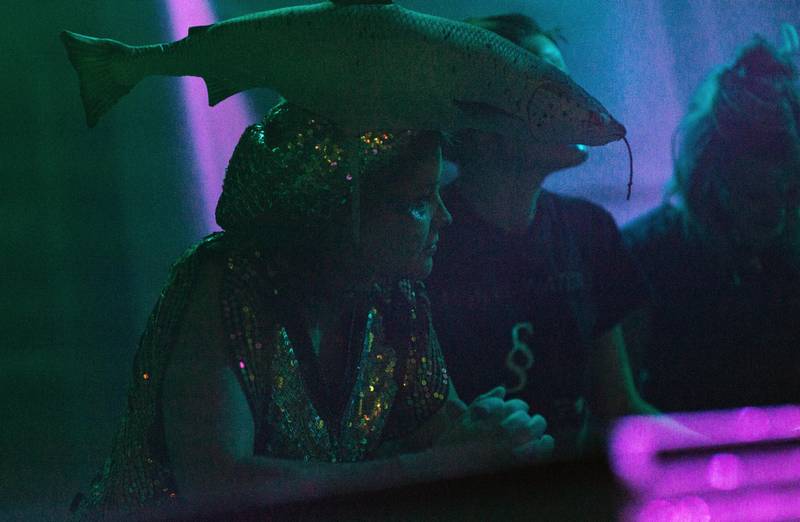

Laura Rämä, Pauliina Feodoroff and Hanna Parry at Vuosttaš álbmogat -klubba, 2017 | Photo: Tani Simberg / Baltic Circle
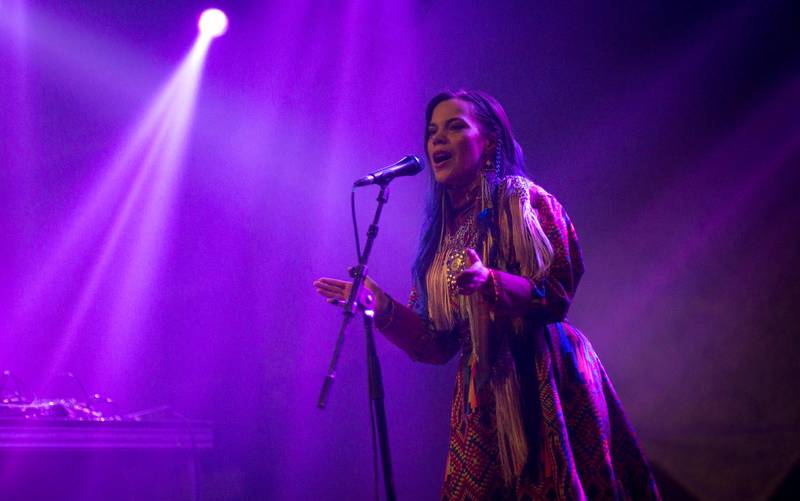

Hildá Länsman at Vuosttaš álbmogat -klubba, 2017 | Photo: Tani Simberg / Baltic Circle
Forest as a Geopolitical Stage (2020-2024) is a four-year art and research initiative and a collaboration between the Finnish National Theater and the Uruguayan NGO PROAC at a time when UPM Kymmene, a Finnish forest industry company is building one of the world’s largest pulp mills in Paso de los Toros, Uruguay. The project investigates art’s role and possibilities amid large-scale and unpredictable social and ecological changes. It aims to bring out perspectives, ask questions about how geopolitical forces change the economic structure, landscape, environment, and social relations, and connect people’s life stories and communities on different continents. The project has several artistic and research outputs: a documentary theater performance, Stories from Carancho, directed by actor-director Jussi Lehtonen and performed by four incarcerated persons in October 2022 at Carancho prison in Rivera, Uruguay. Documentary filmmaker Juan Álvarez Neme followed the working process and is currently making a documentary based on it. The film’s purpose is to make the actors’ voices heard in the public discussion about the incarceration system in Uruguay.
My role in the theater and film productions was to facilitate movement and body-based practices with the actors and to choreograph a scene for the performance and film in collaboration with the participants. In addition, I am mapping the role of art in environmental activism concerning extractivist land use in Uruguay and Finland regarding economic forestry. I visit different contested sites in both countries and conduct interviews with groups that combine art and activism in their campaigns and interventions.
Within the framework of the initiative, The National Theater of Finland has commissioned a new play from Uruguayan theater director and playwright Marianella Morena. The play titled Metsä Furiosa is set in a small town where a large pulp factory is being built, and it examines topics such as colonialism, language, hope, and betrayal. Metsä Furiosa will premiere at the Finnish National Theatre in Helsinki in March 2024. In the same week as the premiere, the research materials and findings of Forest as a Geopolitical Stage will be shared in an open public event where experts from different fields and ways of knowing are invited to talk about the role of forests in geopolitics as well as about the multiple meanings, reciprocities, and acts of care for forests that we have come across during the research.
The conditions of incarcerated people in Uruguay and the forest industry are not directly related, but they are intertwined in the artist residency Campo Abierto, run by the project’s local producer and collaborator, Tamara Cubas. The residency is located in Rivera, next to Carancho prison, surrounded by eucalyptus tree plantations, where the non-governmental organization PROAC, led by Cubas, has for several years made socially engaged art projects and tried to create jobs in the art and cultural industries in the region. Rivera has experienced a big economic change in recent years as more and more local farmers have become pulpwood producers. Locals are particularly concerned about the depletion of groundwater reserves due to the conversion of pampa, characteristic of Uruguay, into large-scale tree plantations, mostly monoculture plantations of eucalyptus. Currently, Uruguay is suffering from the worst drought in 74 years, and the capital region has not had enough public drinking water supplies for months.
Bodily Existence as a Basis for Common Ethics
Art at its best is at the core of common activities: gathering a specific constellation of beings together to consciously intra-act in ways that can only unfold now. It will somehow transform those who engage with it and reverberate beyond. It represents and reflects the conditions and realities of societies and life worlds while creating and shaping them and their visible and invisible conditions. Could attunement and commitment to bodily co-existence be a common ethic to follow? A body in the world among myriad bodies? The terms and conditions of artistic and curatorial processes pour into artworks and art events. For instance, if care and hospitality are orientations to guide artistic and curatorial work, they undoubtedly affect audience encounters and are, in turn, affected by these encounters.
My research aims to find and articulate a methodology of ethical intra-action: a proposal for how embodied curating could be practiced by finding the lowest common denominator to form a connection and following that as a base for a common ethic. I propose bodily existence as the common denominator and look for ways how a connection can be felt. I ask how that can guide our intra-actions and how we act ethically when we are aware of our entanglements, not as one but from our differences. According to Barad, entanglements do not mean interconnectedness but “specific material relations of the ongoing differentiating of the world”. (Barad, 2010, p. 265).
Also, Neimanis points out the importance of not being lulled to think of watery embodiment as oneness without differences and flows of power and privilege: “…we also need to attune ourselves critically to the differences of bodies that together world our planetary hydrocommons. The kind of posthuman phenomenology I am advocating must be committed to feminist but also anticolonial, anti-racist, queer, and crip futures. Even – especially – as our bodies molecularize and destratify, and defy and interrupt our sense of coherently bounded self, the flows of power and restratification are hardly washed away.” (Neimanis, 2017, p. 62)
In a lecture hosted by The Diasporic Schools at Kunstenfestivaldesarts in October 2020, historian and political theorist Achille Mbembe said: “We have become somewhat captive of identity and difference. And in this specific time of the planet’s history, the Anthropocene, it seems to me that our political and critical potential must be directed towards that which is common. Because the challenge we are facing is planetary. It is not simply a challenge posed to humanism; it is a challenge posed to what I call the living. And if we cannot recalibrate our thought in relation to the futures of life or the future of the living, then our history on earth might well end abruptly.”
Joint Bodies as Collective Forces
How do we move from overload and exhaustion to cycles of attention and energy that are alive, nourishing, and resourceful? To start with, listening to the body and taking it seriously. Allowing the cycles and energetic levels of the body to guide working rhythms and decision-making. Instead of perpetually aiming for a generative maximum, aim for the imaginative essential with better conditions and a capacious working process within the available time and budget.
What can a body do by linking with other bodies? How do connections between bodies strengthen their agency and ability to function? When we find ways to connect and form collective bodies, our capacities can expand far beyond the capacities of individual bodies. From riding a wave together to working collectively over a gap over colonial repercussions and reverberations, our embodiments are entangled in complex ways. We must acknowledge the differences that are structural so we can work together towards that which is common.
An individual’s capacity to stay open, attentive, and receptive to art is finite. Exhibitions and performances, especially if they are large-scale, can be overloading and draining. Sometimes they’re energizing too. The same with working in arts – I have exhausted myself as an art worker, and I witness a lot of exhaustion around me. I also get energized from working with people creatively. I have often felt sparked by the energy of my collaborators and sharing space and time with an open and curious public. How do we move from overload and exhaustion to cycles of attention and energy that are alive, nourishing, and resourceful? To start with, listening to the body and taking it seriously. Allowing the cycles and energetic levels of the body to guide working rhythms and decision-making. Instead of perpetually aiming for a generative maximum, aim for the imaginative essential with better conditions and a capacious working process within the available time and budget. This can be possible if we consider that curating is about finding structures and conditions that support particular content and then forming a constellation of bodies and things that gather in a specific space and time. Too much structure or too much content stagnates energy, whereas their insufficiency collapses it. There must be just enough structure and content to create a container where energy can circulate and something unexpected can unfold.
Through attuning to each other’s bodies, we can recognise ways to connect and coexist, to affect and be affected, which is at the core of political agency.
What if our strength lies in our instinct
To wind together and swell into a chorus,
Each of us a tone in a chord vibrating with
The past and yet imagined futures.
(Okpokwasili, 2019)
